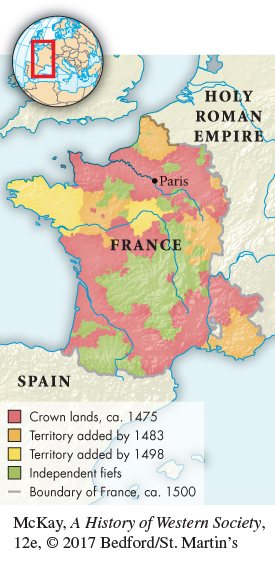A History of Western Society: Printed Page 383
A History of Western Society, Value Edition: Printed Page 367
A History of Western Society, Concise Edition: Printed Page 383
France
The Black Death and the Hundred Years’ War left France drastically depopulated, commercially ruined, and agriculturally weak. Nonetheless, the ruler whom Joan of Arc had seen crowned at Reims, Charles VII (r. 1422–1461), revived the monarchy and France. He seemed an unlikely person to do so. Frail, indecisive, and burdened with questions about his paternity (his father had been deranged; his mother, notoriously promiscuous), Charles VII nevertheless began France’s long recovery.
Charles reconciled the Burgundians and Armagnacs (ahr-

By establishing regular companies of cavalry and archers — recruited, paid, and inspected by the state — Charles created the first permanent royal army anywhere in Europe. His son Louis XI (r. 1461–1483), called the “Spider King” because of his treacherous character, improved upon Charles’s army and used it to control the nobles’ separate militias and to curb urban independence. The army was also employed in 1477 when Louis conquered Burgundy upon the death of its ruler Charles the Bold. Three years later, the extinction of the house of Anjou with the death of its last legitimate male heir brought Louis the counties of Anjou, Bar, Maine, and Provence.
Two further developments strengthened the French monarchy. The marriage of Louis XII (r. 1498–1515) and Anne of Brittany added the large western duchy of Brittany to the state. Then King Francis I and Pope Leo X reached a mutually satisfactory agreement about church and state powers in 1516. The new treaty, the Concordat of Bologna, approved the pope’s right to receive the first year’s income of newly named bishops and abbots in France. In return, Leo X recognized the French ruler’s right to select French bishops and abbots. French kings thereafter effectively controlled the appointment and thus the policies of church officials in the kingdom.